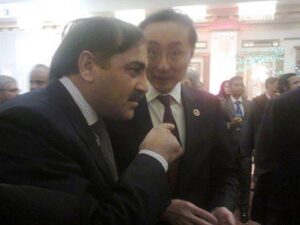By Qamar Bashir
While the West devastated Afghanistan through decades of war, drone strikes, and
foreign occupation, China took a different path—quiet, strategic, and respectful. As
American troops dropped bombs and NATO scrambled for exits, China was building
something far more enduring: relationships, trust, and long-term partnerships—not with
governments or factions, but with the people themselves.
China never intervened in internal conflicts. It didn’t back one militia over another or try
to redesign Afghanistan in its own image. Instead, it reached out to Afghan farmers,
miners, traders, and workers—those who hold the real stake in a nation’s future. China
didn’t issue ultimatums or demand allegiance. It offered trade, development, investment,
and a shared vision rooted in mutual benefit. While others saw Afghanistan as a
battlefield, China saw it as a bridge. And now, that vision is taking form.
On May 21, 2025, a landmark “informal” meeting in Beijing brought together the foreign
ministers of China, Pakistan, and Afghanistan. More than handshakes and smiles, it
marked a strategic turning point: the decision to extend the China-Pakistan Economic
Corridor (CPEC) into Afghanistan. A decision that could not only reshape the region,
but offer Afghanistan a real shot at peace—on Afghan terms.
CPEC, the flagship of China's Belt and Road Initiative, has already transformed Pakistan
with highways, ports, power plants, and rail links. Now, Afghanistan joins this evolving
network—not as a dependent state, but as a vital partner. This is not just about
infrastructure; it’s about integration. Roads will link not only cities, but economies.
Corridors will connect not only markets, but destinies.
Importantly, the emphasis is not just on “hard” connectivity—rails, roads, ports—but also
on “soft” connectivity: harmonizing regulations, easing trade, facilitating the movement
of people, and respecting local customs and social structures. It’s a nuanced,
sophisticated model. One that does not demand political alignment but offers economic
alignment.
And within this spirit of integration, other dormant regional initiatives are regaining
momentum—CASA-1000, TAPI, the Trans-Afghan Railway—each poised to support
energy sharing, trade expansion, and regional mobility.
What sets China apart is its commitment to letting Afghanistan rebuild itself—on its
own cultural, social, and religious terms. There is no political engineering. No social or
cultural meddling. China is not offering a model to impose; it is offering a hand to uplift.
And that matters in a land long scarred by foreign interference.
This new economic vision will allow Afghanistan to thrive the Afghan way. Under the
guidance of its traditions, shaped by the values of its people, and led by the social fabric
rooted in the Pashtunwali code, Afghanistan can now envision a future that is both
modern and authentic.
In the same meeting, the three nations also addressed regional peace and stability with
clarity and resolve. They jointly emphasized that no group or actor—whether Tehreek-e-
Taliban Pakistan (TTP) or the Eastern Turkistan Islamic Movement
(ETIM)—would be allowed to use their territories to threaten regional security.
But this was not a military statement. It was a reaffirmation that true security is a
product of stability and opportunity, not surveillance and subjugation. And for the first
time in years, regional players are aligning not around ideology, but around
infrastructure, integration, and mutual interest.
The commitment to non-interference in Afghanistan’s internal affairs—a principle
stressed by all three parties—further highlights the maturity of this partnership. Where
others tried to rule, this alliance seeks to support.
This development also sends a gentle but clear message to powers like the United
States, the broader West, and even India: peace is not built through pressure or
presence—it is earned through partnership.
India, in particular, is watching this shift with unease. Having long opposed CPEC due to
its passage through Pakistan-administered Kashmir, New Delhi now sees its regional
influence challenged by a deepening China-Afghanistan-Pakistan axis. Its strategic
projects like Chabahar Port and regional outreach to Central Asia now face real
competition.
But perhaps this is also a moment for reflection. What has military intervention
achieved that peaceful development cannot exceed? What has isolation created that
connectivity cannot heal?
Afghanistan, long viewed as a crossroads of conflict, is now being prepared to become a
corridor of cooperation. With CPEC stretching into its heartlands, Afghan traders will
gain access to global markets. Afghan workers will have new employment prospects.
Afghan youth will see schools grow, roads built, and hope return.
This transformation won’t happen overnight—but it is no longer a fantasy. With $40–50
billion in projected regional investments, trade volume expected to multiply, and
transit routes expanding across borders, Afghanistan is poised to become a
pivot—linking South Asia to Central Asia, the Middle East, and beyond.
China’s approach isn’t just strategic—it is profoundly human. It understands that the way
to build peace is to help people live with dignity. To give them something to lose—and
thus, something to protect. And that’s exactly how China transformed Xinjiang—by
investing in education, skills, industries, and livelihoods. Now, the same model is being
softly replicated in Afghanistan.
With China’s integrated, respectful, and win-win approach, a new Afghanistan is within
reach—one where terrorism fades into irrelevance, schools thrive, trade routes flourish,
and airports once again welcome the world. Roads of international standard will connect
the country to the region. Its corridors will pulse with economic life. Its cities will hum
with opportunity.
And most importantly, this prosperity will belong to Afghans. It will be shaped by their
traditions, guided by their values, lived according to their social norms, and honored
through their timeless Pashtunwali code. No foreign model will be imposed. No social
fabric will be rewritten. No cultural identity will be challenged.
This is not a distant hope. It is a near and unfolding reality. Under China’s guidance
and with regional cooperation, Afghanistan is no longer the world’s forgotten
battlefield. It is becoming its new bridge—linking civilizations, reviving ancient trade
routes, and lighting a path toward shared peace and prosperity.
-Writer is Press Secretary to the President (Rtd)
Former Press Minister at the Embassy of Pakistan to France
Former MD, SRBC
Macomb, Michigan, USA




